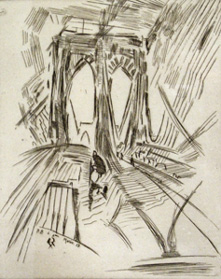John Marin A Print Survey
John Marin A Print Survey
In the cities of the early 20th century, John Marin (1870-1953) observed “great forces at work;” it was that force Marin deftly captured in his etchings of Paris and New York. The University of Maine Museum of Art will present a selection of etchings, hand-printed by Marin, of these urban visions.
John Marin was born in Rutherford, New Jersey in 1870. A self-described failure at business, Marin initially considered becoming an architect, working from 1893 -1995 as a freelance architect. During this time Marin became increasingly interested in sketching and enrolled in art school. He studied at the Pennsylvania Academy of Fine Arts in Philadelphia from 1899 -1901 and the Art Students League in New York during 1904. In 1905 Marin went to Paris, where his father helped finance his art career. Within a year of moving to Europe, Marin began etching. Drawing upon his earlier attempts at architecture he etched scenes from the city. Marin, wanting to capture the spontaneity of the scene, often etched directly on to copper plates, thereby leading to final prints that were the mirror images of the actual cityscape. From Paris, Marin also visited Amsterdam where he made numerous etchings and paintings, and later traveled to London and Venice. During his Venice trip, Marin honed his technique of capturing his impressions of a place – its life – rather than just an accurate, but lifeless, copy of a group of buildings. As time went by, he began to shed the more architectural concerns of representation and focus on just the essentials of a building; after 1908 his etchings became more loose and freeform. Marin often worked through his ideas with preliminary versions. An accomplished printmaker, he often used a single plate to experiment with various methods of printing and would often mark the prints with his evaluation or notation (e.g. A1, Best print, a Beaut, etc.) Marin adopted the practice of etching his name and the date directly into the plate; those prints that did go out into the art world were usually signed in pencil. After Marin met Alfred Steiglitz in 1909, he returned to the United States where the photographer served as his patron. That same year Marin had his first solo exhibition at Stieglitz’s Photo-Secession Gallery but returned briefly to Europe in 1910-1911 before settling permanently in the US. Steiglitz became an early collector of Marin’s plates, proofs, and etchings and his extensive collection is now at the Metropolitan Museum of Art.
John Marin lived in Cliffside, New Jersey from 1916 until his death in 1953 while spending his summers in the Berkshires, the Adirondacks, the Delaware River country and Maine. Most of all he loved the coast of Maine, summering in Small Point or Deer Isle and from 1933-1953 at Cape Split.

Brooklyn Bridge, No. 6 (Swaying), 1913
Etching
